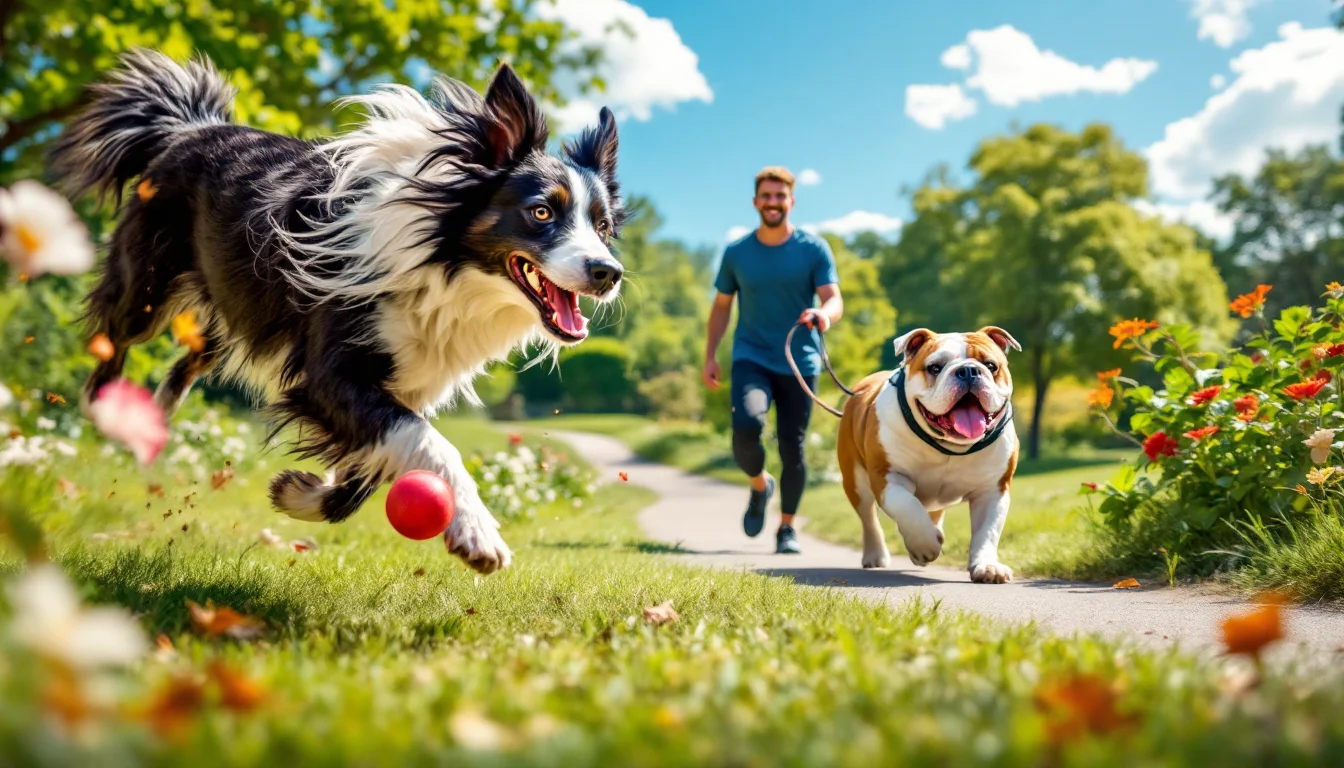Living with multiple dogs is a joy, but when each dog has its own energy level, breed traits, and age, keeping them all happy and properly exercised can be a real challenge. Some dogs need intense physical activity, while others are content with a short daily walk and a nap.
This guide will help you manage the different exercise needs of your dogs, creating a routine that keeps every pup physically and mentally stimulated — no matter their breed or energy level.
Why Exercise Needs Vary Between Dogs
Exercise isn’t just about burning energy; it supports overall health, behavior, and emotional well-being. However, several factors determine how much and what type of exercise your dog needs:
- Breed: Working breeds like Border Collies and Huskies need significantly more exercise than companion breeds like Shih Tzus.
- Age: Puppies and young adults have high energy, while seniors may prefer gentle activities.
- Health: Dogs with joint issues or other conditions need low-impact movement.
- Personality: Even among the same breed, individual dogs have different levels of drive and stamina.
Understanding each dog’s needs is key to preventing boredom, behavioral issues, and physical strain.
Categorizing Your Dogs’ Energy Levels
Start by evaluating the energy level of each dog. This helps you plan personalized routines.
High-Energy Dogs
Examples: Huskies, Border Collies, Labradors, Belgian Malinois
- Require 1.5 to 2 hours of activity daily.
- Thrive on structured exercise and mental stimulation.
- Love tasks, games, and learning new commands.
Medium-Energy Dogs
Examples: Beagles, Cocker Spaniels, Australian Shepherds
- Need 45 minutes to 1 hour of activity.
- Enjoy daily walks, moderate play, and occasional training sessions.
Low-Energy Dogs
Examples: Bulldogs, Basset Hounds, Chihuahuas (often)
- Require 20 to 30 minutes of gentle activity.
- Prefer short walks and playtime at home.
By identifying these categories, you can build a routine that keeps everyone active and content.
Creating Individual Routines
Rather than forcing all your dogs to exercise together, create flexible routines:
- Solo walks or runs: Take high-energy dogs out for longer walks or jogs. Later, take your low-energy pup on a shorter stroll.
- Staggered play sessions: Let the most energetic dog play fetch in the yard while the others rest.
- Rotating toys and games: Each dog may enjoy different types of stimulation — some love chew toys, others prefer scent games.
This ensures each dog gets the right amount of movement without being over- or under-exercised.
Mental Stimulation Is Just as Important
Exercise isn’t only physical. Mental enrichment helps reduce anxiety and boredom, especially for intelligent breeds.
Activities that work for all energy levels:
- Puzzle feeders
- Scent tracking games
- Basic obedience or trick training
- Interactive toys
Use mealtime as a training opportunity or challenge them with toys that require problem-solving to access treats.
Using the Right Equipment
Each dog’s size, breed, and energy should dictate the equipment you use:
- Harnesses for strong pullers (especially large breeds).
- Retractable leashes for dogs who enjoy sniffing but aren’t reactive.
- Hands-free leash systems for walking two dogs at once, if their energy levels align.
Ensure collars and harnesses fit properly and always supervise play, especially between dogs with mismatched sizes.
Managing Group Activities
While individual exercise is ideal, dogs can still enjoy group activities — just with supervision and structure.
Ideas:
- Pack walks at a controlled pace.
- Group fetch with controlled throws.
- Training sessions where each dog waits their turn.
Avoid high-energy play between dogs with a large size or strength difference to prevent injury.
Handling Puppies and Seniors Together
This combination is common — and tricky.
Puppies:
- Need short, frequent play sessions.
- Benefit from early socialization and basic training.
Seniors:
- Prefer low-impact activities like short walks or swimming.
- Need rest and comfortable recovery time.
Give each their own space, and don’t force older dogs to keep up with the young ones. Respect their physical limits.
Avoiding Overexertion
It’s easy to accidentally overwork a dog, especially in group play.
Watch for signs of fatigue:
- Excessive panting
- Slowing down
- Reluctance to move
- Limping or stiffness after activity
Always offer water, shade, and rest periods. Adjust intensity based on weather, especially with brachycephalic (short-nosed) breeds like Bulldogs or Pugs.
Keeping It Fun for Everyone
Boredom can lead to destructive behavior, but a balanced routine solves that.
Mix things up:
- One-on-one fetch in the backyard
- A nature walk for your explorer
- Indoor tug or hide-and-seek on rainy days
- Dog sports like agility or rally obedience for active breeds
Rotate activities to keep each dog mentally engaged and excited.
Final Thoughts: Harmony Through Routine
Managing dogs with different exercise needs doesn’t require hours at the dog park every day — it’s about understanding and flexibility. By tailoring activities to each dog’s requirements and personality, you’ll prevent frustration, reduce behavior problems, and build a stronger bond with each pup.
It might take some trial and error, but with consistency and patience, you’ll develop a routine that works for your whole furry family — from the couch potato to the marathon runner.

Dedicated to sharing practical tips and accessible guidance on dog care, nutrition, safety, and daily routines for owners of different breeds. With a focus on promoting a safe, healthy, and happy environment for pets, the blog’s content covers breed-specific needs, home adjustments, energy levels, and wellness strategies for all kinds of dogs.
